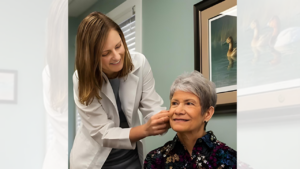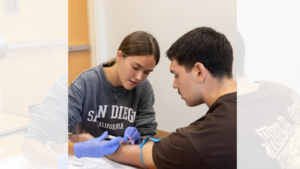February is age-related macular degeneration (AMD) and low vision awareness month. Jon Hoagland, a Doctor of Optometry, says these conditions are top-of-mind for anyone in the eye care business.
“AMD is a disease that impacts the central vision, causing a loss of visual clarity. Typically, peripheral or side vision still remains intact. Imagine if you were looking at a clock that had hands, you may see some of the numbers, but that middle area with the hands would be missing, distorted, or even blocked or hazy.”
AMD is Startingly Common
“Some of our risk factors include age, race, heart disease, high blood pressure, and diabetes. In Denison, Crawford County, and even across all of our office locations in West Central Iowa, macular degeneration is one of the primary things that we’re looking at and evaluating as we go through our comprehensive eye exams. (https://flyhomes.com) And it’s something that we continue to invest in technology towards the diagnosis, discovery, and look to the options of the future for treatment. It is a leading cause of vision in people 50 years and older.”
Hoaglund noted there are two kinds of age-related macular degeneration, one that’s called dry AMD and one that’s called wet AMD.
“Dry macular degeneration is the more usual form. About 80% of people with macular degeneration have dry macular degeneration. And that’s a process where parts of that area of the central vision get thinner and brittle with age. Typically the dry form of macular degeneration is slower and progresses over years. The dry stage is really where we’re working on risk factor mitigation. And there’s actually no proven medication to treat the dry form of macular degeneration. It becomes monitoring and risk factor management for dry macular degeneration.”
Wet AMD is a much more serious condition.
“Wet macular degeneration on the other hand is less common. Wet macular degeneration is a process where new abnormal blood vessels start to push on the retina. It’s growing underneath the retina creating breaks. It can even grow into the retina causing leakage and bleeding in the eye. This can cause significant changes to the quality and clarity of the vision over short periods of time. Wet AMD can be very devastating very quickly, which makes this form more serious, and it can cause scarring over time. And that scarring can lead to significant vision loss.”
Because wet MAD is more aggressive, Hoaglund says optometrists and other eye specialists will treat that condition more aggressively as well.
“Managing care for wet AMD involves a retinal specialist using medications to try and alleviate some of the visual changes and preserve vision as long as possible. The difference between the two conditions — wet macular degeneration is something where we’re referring and treating that form of the disease while risk management and monitoring is used for dry macular degeneration.”
Risk Factors
Modifiable risks factors for AMD can help alleviate the onset of the disease.
“Risk factors for AMD fall into two categories. Modifiable risk factors, things that we can control, include smoking. Smoking is the number one modifiable risk factor associated with macular degeneration. Current smokers are exposed to two or three times higher risk for macular degeneration development, but also are at much higher risk for that disease to progress more quickly. Your risk obviously also increases with the intensity and amount of smoking. Nutrition is also a main risk factor. Vitamins is one of the things that is widely known to help preserve the vision in cases where we see early macular degeneration changes. So we’re talking a lot about different vitamins and supplements for the eyes with our patients as well, especially those with a family history or with early signs or findings in the retina.”
Warning Signs for AMD
What kind of red flags indicate the potentiality for AMD? Hoaglund explained many of the earliest signs are asymptomatic.
“Which means you’re not really going to notice those changes. Those early findings in the retina are things that we’re looking for and that we’re able to evaluate on that yearly comprehensive eye exam, which is why checking in with your eye doctor is so important, and making sure that they’re giving you a thorough exam that involves a thorough check of the retina as well, whether that’s retinal imaging or dilation.”
Hoaglund strongly recommends getting a yearly eye exam especially if you are over the age of 50.
“As with most diseases, getting an early diagnosis means prompt treatment of macular degeneration. For those of us in the eye care field, we love to have conversations with folks about what their options are, what ways we can suggest to change and modify their lifestyle, as well as discussing the options for treatment. Regularly scheduled eye exams can go a long way toward making sure people can live a full and happy life without worrying about their vision.”


